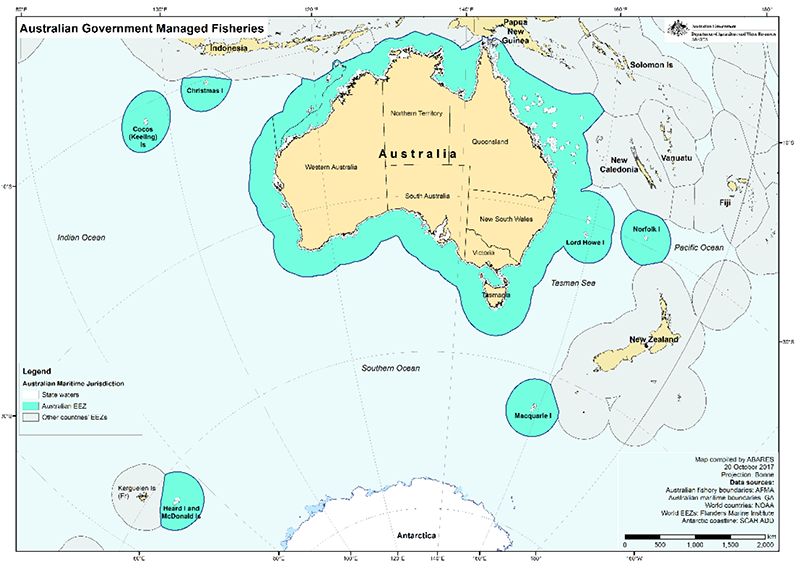Authors: James Woodhams and Cher Harte
Overview
This report provides a synthesis of management arrangements, catch and sustainability of sharks across Australia. This report is a commitment under the United Nations Food and Agriculture Organisation's International Plan of Action for the Conservation and Management of Sharks and Australia's National Plan of Action for the Conservation and Management of Sharks.
[expand all]
Background
In 1994, the ninth conference of parties to the Convention on International Trade in Endangered Species of Wild Fauna and Flora (CITES) adopted a resolution on the status of international trade in shark species. The resolution called for a review of information on the global status of shark stocks and the impact of trade on those stocks. In 1999 the Food and Agriculture Organization (FAO) of the United Nations released the International Plan of Action for Conservation and Management of Sharks (IPOA‒Sharks).
The IPOA‒Sharks is a voluntary instrument that directs FAO member states to ‘adopt a national plan of action for the conservation and management of shark stocks (NPOA‒Sharks) if their vessels conduct directed fisheries for sharks or if their vessels regularly catch sharks in non-directed fisheries’. The IPOA‒Sharks directs those states that implement an NPOA‒Sharks to assess it regularly (at least every four years) to identify cost-effective strategies for increasing its effectiveness.
Australia developed its first NPOA‒Sharks in 2004 (DAFF 2004). This drew on information in the first shark assessment report (DAFF 2001). The second shark assessment report incorporated catch and effort data to 2005–06 and management information up 2009 (Bensley et al. 2010). The second shark assessment report supported the development of the second NPOA‒Sharks (DAFF 2012).
The Department of Agriculture and Water Resources commissioned this (the third) shark assessment report to inform the development of the next NPOA‒Sharks. The 2018 shark assessment report builds on information provided in the 2001 and 2009 reports and provides updated information on:
- resource information, including shark catch, trade and stock status
- fisheries management and regulatory frameworks
- conservation and management arrangements.
Data and information
This shark assessment report has been prepared with the assistance of Australian, state and Northern Territory fisheries agencies and members of the Shark-Plan Representative Group (SRG). The SRG was established to oversee and report on implementation of the NPOA operational strategy. This shark assessment report incorporates publicly available information and data from each jurisdiction on shark catch and management. This report also includes trade data produced by the FAO and Australian Bureau of Statistics (ABS).
The 2018 shark assessment report focuses on data between 2006–07 and 2014–15. Every attempt has been made to ensure that these data are accurate at the time of publication.
Much of the information presented in the 2001 and 2009 shark assessment reports remains unchanged and is not replicated in this report. This report uses standard Australian fish names.
Australian Fishing Zone
State and territory fisheries agencies generally manage fisheries out to 3 nautical miles, while the Australian Government manages fisheries in waters from 3 nautical miles out to 200 nautical miles. There are several exceptions to this general rule, with a number of Offshore Constitutional Settlement (OCS) arrangements established to manage fish stocks that occur in more than one marine jurisdiction. Under these OCS arrangements, fishing for a particular fish stock may be managed either through joint authority arrangements made between two or more jurisdictions or by transferring management of a straddling stock to a single jurisdiction. For example, under OCS arrangements, the Commonwealth manages commercial fishing for school shark (Galeorhinus galeus) and gummy shark (Mustelus antarcticus) stocks in coastal waters off south-eastern Australia on behalf of Victoria, South Australia and Tasmania.
This report principally considers data and information for fisheries operating within the Australian Fishing Zone (Map 1). Some information is also presented for straddling and/or high seas stocks.

Download the full report
Shark Assessment Report 2018 PDF  [1.2 MB, 39 pages]
[1.2 MB, 39 pages]
Shark Assessment Report 2018 DOCX  [1.4 MB, 39 pages]
[1.4 MB, 39 pages]
